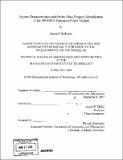System characterization and online mass property identification of the SPHERES formation flight testbed
Author(s)
Berkovitz, Dustin S. (Dustin Scott)
DownloadFull printable version (25.95Mb)
Alternative title
System characterization and online mass property identification of the Synchronized Position-Hold, Engage, Reorient Experimental Satellite formation flight testbed
Other Contributors
Massachusetts Institute of Technology. Dept. of Aeronautics and Astronautics.
Advisor
David W. Miller.
Terms of use
Metadata
Show full item recordAbstract
The National Aeronautics and Space Administration (NASA) and other entities in the aerospace industry have recently been considering distributed architectures for many space applications, such as space-based interferometry. Whether the craft in such a system are structurally connected or flown in tight formation, distribution allows for higher redundancy in case of failures as well as reducing the minimum payload footprint for launch. Designed to fly in precise formation, the SPHERES satellites rely on accurate system characteristics such as thruster strength and vehicle mass and inertia. The SPHERES testbed is described and the applications for formation flight are presented. Mass properties of the SPHERES satellites are examined because of their impact on control determination, with comparison between CAD model estimates and empirically determined values. The sensor and actuator suite, essential for closed-loop control, are also identified and characterized. A recursive least squares algorithm for determining mass properties in real time is explained and implemented both offline and online with results from test flights aboard NASA's KC-135 micro-gravity aircraft (Reduced Gravity Airplane, RGA).
Description
Thesis (S.M.)--Massachusetts Institute of Technology, Dept. of Aeronautics and Astronautics, 2008. Includes bibliographical references (p. 89-91).
Date issued
2008Department
Massachusetts Institute of Technology. Department of Aeronautics and AstronauticsPublisher
Massachusetts Institute of Technology
Keywords
Aeronautics and Astronautics.